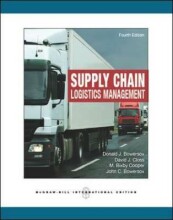Summary: Manufacturing Planning And Control For Supply Chain Management | 9780071313933 | F Robert Jacobs
- This + 400k other summaries
- A unique study and practice tool
- Never study anything twice again
- Get the grades you hope for
- 100% sure, 100% understanding
Read the summary and the most important questions on Manufacturing planning and control for supply chain management | 9780071313933 | F. Robert Jacobs ... [et al.].
-
1 Manufacturing planning & control (MPC)
This is a preview. There are 3 more flashcards available for chapter 1
Show more cards here -
Define Manufacturing planning and control
- Concerned with planning and controlling all aspects of manufacturing, including managing materials, scheduling machines and people, and coordinating suppliers and key customers.
- A model for evaluating responses to changes in the competitive environment;
- Coordinate supply chain, joint efforts across company boundaries;
- Respond to changes in the company environment, strategy, customer requirements, practical problems and new supply chain opportunities;
- What should the firm, together with its supply chain partners, do next?
-
What's a MPC system?
MPC system = to manage efficiently the flow of material, to manage the utilization of people and equipment, and to respond to customer requirements by utilizing the capacity of our suppliers, internal facilities and sometimes meet customer demand. -
What are key influences on MPC?
- Breadth and depth of globalization: fast growing economies, international agreements trends
- 'Hallow' corporation: supply chain director
- Plug - in compatibility: give component specification and they can produce --> contract manufacturing
- Quickly shifting collaborations: supply chain or supply networks.
-
What's the key to keep the MPC system matched to the evolving company?
- The key to keeping the MPC system matched to evolving company needs to Ensure system activities are synchronized and focused on the firm's strategy. The need for matching is ongoing:
- The changing competitive world; new technology, products, processes, systems and techniques permit new competitive iniatives; global competition intensifies many of these forces.
- Shorter product lifecycle: consumers have access to products from all over the world --> Time based competition (who can get to the market quickest?)
- Cost and quality are the ante to play the game.
- The key to keeping the MPC system matched to evolving company needs to Ensure system activities are synchronized and focused on the firm's strategy. The need for matching is ongoing:
-
What's needed to react to changes (forces of change: technology, products, processes, systems and techniques)?
- New modules or information may be required
- In SCM approaches, the emphasis shifts to the total costs in the joint activities of more than one firm.
- Need for evolution in MPC systems --> Period auditing.
-
Describe Enterprise Resource Planning (ERP)
- ERP provides the information backbone needed to manage day to day execution;
- ERP represents a comprehensive software approach to support decisions concurrent with planning and controlling the business;
- ERP is a term to describe a software system that integrates application programs in all organizations functions;
- ERP aims at horizontal integration of activities/ processes.
-
2 Demand management (DM)
This is a preview. There are 2 more flashcards available for chapter 2
Show more cards here -
Define demand management (DM)
How a firm integrates information from and about its customers, internal and external to the firm, into the MPC system.
Activities include: demand determination, converting customer orders into delivery promises, balancing supply with demand and (demand shaping). -
What's the link between demand management and MPC systems?
DM is a gateway module in MPC providing the link to the Marketplace, sister plants, warehouses and other important customers.
MPC = determining the capacity that will be made available to meet actual future demands for products. -
What is the distinction between forecasts and plans?
- Forecast = quantities and timing of customer demand are developed. Estimates of what might occur in the Marketplace;
- Plan = specify how the firm will respond are based on the forecasts (highly seasonal products, snowboards; peaks demand, constant plan);
- Independent demand = what customers decide (known or forecast);
- Dependend demand = internal demand based on our plan (snowboards).
-
What's the link between DM and MPC environment?
- Customer order decoupling point (order penetration point) = point at which demand changes from independent to dependent (MTS/ ATO/ MTO/ ETO);
- Firm becomes responsible for determining the timing and quantity of material to be purchased, made or finished.
- Higher grades + faster learning
- Never study anything twice
- 100% sure, 100% understanding































